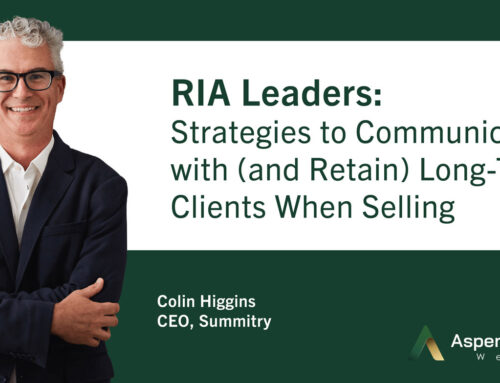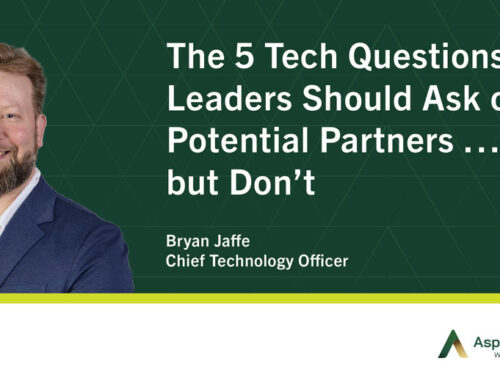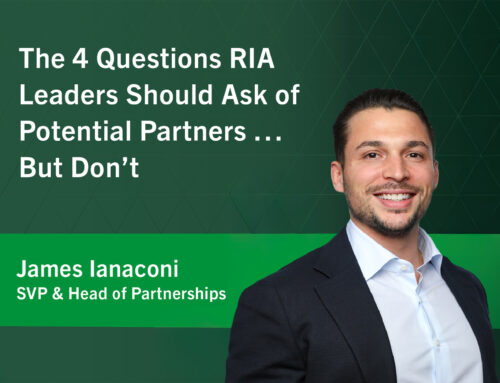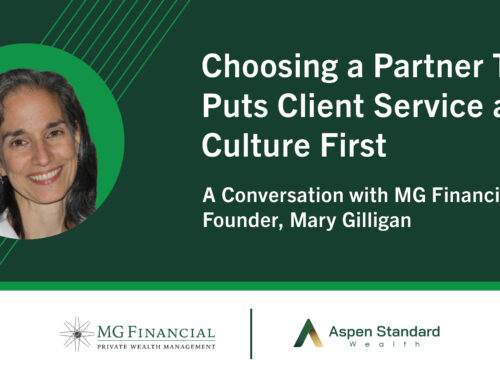By Kate Moulton Chmielewski, Partner, Head of Marketing, Aspen Standard Wealth
The RIA industry has long relied on referrals and word-of-mouth to grow. However, that understated approach no longer works on its own. In a hyper competitive and digital-first world, organic growth requires a much more strategic marketing approach. In the highly fragmented RIA landscape, marketing is not just about brand visibility—it’s about differentiation, trust-building, and long-term sustainability.
Many still believe that marketing is just about making something “look pretty”—a phrase that makes every modern, savvy marketer cringe. Equal parts art + science, marketing is far more than aesthetics; it’s a growth engine that fuels business success, aligns messaging with client needs, and ensures firms stay relevant in a rapidly evolving marketplace. Without it, even the best firms can go unnoticed and quickly fall behind their competition.
The most successful RIAs invest in their marketing engine and lean into it as a core driver of growth. By integrating an omni-channel marketing program into their overall business strategy, RIAs can create sustainable momentum and a competitive advantage. Below are 8 ways how…
1. Building Brand Awareness & Credibility
Trust is the foundation of any financial relationship. Ultimately, an RIA’s brand is rooted in trust, which plays a crucial role in establishing credibility.
RIAs with strong branding and consistent messaging stand out in a crowded market. Without a clear and recognizable brand, potential clients may overlook a firm in favor of more visible competitors. With more than 15,000 RIAs in market, it is essential that they make the effort to not only define their brand but actively and consistently communicate to existing and prospective clients alike.
One way to do that is by developing and sharing thought leadership through relevant mediums and channels—such as blogs, podcasts, social media, and live speaking engagements—which enhance credibility. When RIAs consistently share valuable insights on financial trends and strategies, they reinforce their expertise and authority, thereby accentuating their brand.
And remember, a brand isn’t a font or a logo; it is how someone feels when they think about and/or interact with your product or service. It’s the whole experience: from how you advertise, to how quickly you answer an email, to the thoughtful book you sent your client’s daughter when she graduated.
Key Takeaway: A consistent, well-defined brand increases trust and helps convert prospects into clients.
2. Differentiation in a Competitive Market
With thousands of RIAs competing for attention, a firm must clearly and consistently communicate what makes it unique. Whether it’s a niche focus (e.g., business owners, physicians, retirees), investment philosophy, or service model, marketing helps highlight differentiation. A well-defined unique value proposition, or “UVP,” helps ensure that potential clients understand why an RIA is the right choice for them. The key is specificity. Every RIA will claim to be “client centric” or “act in the best interests” of their clients. Take the time to figure out what really sets your firm apart, that “secret sauce.” Lean into that differentiation and amplify it at every opportunity.
Key Takeaway: A compelling and unique brand message helps an RIA stand out and attract the right clients.
3. Enhancing Client Engagement and Retention
Marketing isn’t just for acquiring new clients—it’s critical for strengthening relationships with existing ones. Email newsletters, exclusive webinars, and timely social media updates are just a few of the ways that RIAs can keep clients engaged and informed. Consistent, relevant communication reassures clients that they are in good hands and strengthens their loyalty.
Proactive communication also prevents attrition and increases lifetime client value. Clients want to feel that their advisor is invested in their financial well-being beyond portfolio management. By consistently providing relevant insights and personalized outreach, RIAs can deepen relationships, maintain long-term engagement, and set themselves up to receive client referrals. Current client engagement is just as, if not more important, as marketing to new prospects.
Key Takeaway: RIAs that consistently engage their clients foster loyalty and long-term advocacy.
4. Driving Lead Generation Beyond Referrals
Diversify, diversify, diversify! While referrals are a valuable source of growth, they can be unpredictable and slow. RIAs should always have several channels “open” to actively solicit leads from various sources. A strong digital marketing strategy—including search engine optimization (SEO), content marketing, and paid advertising—can generate a steady pipeline of qualified leads. By optimizing their online presence, RIAs can continually attract prospects actively searching for financial expertise.
RIAs that invest in inbound marketing build a foundation for sustainable growth. A well-executed lead gen strategy ensures that firms are consistently bringing in prospects, reducing dependency on referrals alone.
Key Takeaway: Digital marketing diversifies lead generation and creates consistent organic growth.
5. Establishing Thought Leadership and Trust
It should come as no surprise that clients want to work with trusted experts. Publishing insightful content, appearing in media outlets, and speaking at industry events can position an RIA and its people as thought leaders that are worth doing business with. When RIAs include a thought leadership approach to marketing, they reinforce their expertise without feeling overly sales driven.
Social media is an excellent, engaging, real-time way to promote thought leadership content. A strong social media presence (LinkedIn, Facebook, YouTube) builds credibility and engagement, especially when promoting or sponsoring posts with advertising to greatly increase the reach to very specific audiences. By sharing thoughtful insights and perspectives of interest to target audiences, RIAs create a steady stream of helpful content that reinforces their expertise.
Key Takeaway: Thought leadership-based marketing strengthens reputation and fosters client confidence and trust.
6. Leveraging Technology and Data for Growth
Modern marketing tools help RIAs track performance, automate campaigns, and optimize engagement. Customer relationship management (CRM) systems like HubSpot, Salesforce, and others can deeply personalize outreach and engagement, ensuring that potential clients receive timely and relevant information that is specific to their wants and needs. Marketing automation allows firms to scale their efforts efficiently without sacrificing quality or the sense of bespoke client interactions.
Analytics tools provide insights into what messaging resonates with prospects. By leveraging data, RIAs can fine-tune their marketing approach and allocate resources more efficiently. Data-driven marketing lets firms focus on the strategies delivering the best return on investment, improving conversion rates over time.
Key Takeaway: Data-driven marketing enables smarter decision-making and higher ROI.
7. Regulatory- & Compliance-Friendly Marketing as a Differentiator
Many RIAs avoid marketing due to compliance constraints. That creates an opportunity for those who do it right. The SEC’s updated marketing rule allows for client testimonials and endorsements—when done within regulatory guidelines. Compliance-conscious marketing can help firms gain a competitive edge while staying within the legal framework.
Key Takeaway: RIAs that embrace compliant marketing strategies can differentiate themselves and build trust where competitors hesitate.
8. The Shift from Product-Centric to Client-Centric Marketing
Clients seek a very personal approach, not just someone slinging generalized financial products. RIAs must tailor their messaging to address client pain points and goals. Marketing strategies that prioritize the client experience, such as segmented email campaigns, targeted content, and personalized outreach (made possible by a well-built-out data regime) result in stronger relationships and increased trust.
Firms that shift away from a purely product-driven approach to one centered around client needs are more likely to retain and attract high-value clients. By demonstrating empathy, understanding, and a focus on individual financial aspirations, RIAs can create a more engaging and valuable client experience.
Key Takeaway: A client-first marketing approach fosters deeper relationships and long-term loyalty.
Organic growth no longer happens by chance—it requires a strategic, targeted marketing investment. By building brand awareness, differentiating services, and leveraging digital tools, RIAs that embrace modern marketing techniques will be best positioned for long-term success.
At Aspen, we understand the unique challenges RIAs face in growing their businesses while maintaining high-touch client service. That’s why building and optimizing scalable marketing and lead generation programs is a cornerstone of our strategy—because we know the measurable growth it drives.
From brand positioning and digital strategy to content marketing and referral amplification, Aspen provides tailored solutions that empower RIAs to attract, engage, and convert their ideal clients—without sacrificing the personal relationships that make them successful.
Ready to take your RIA’s growth to the next level? Let’s connect to craft a tailored marketing strategy that accelerates your firm’s growth.




